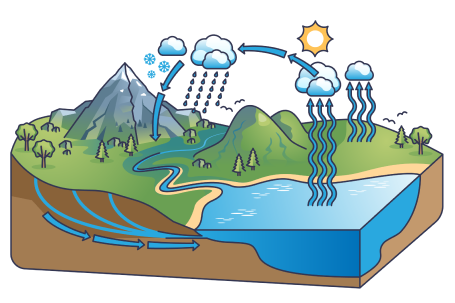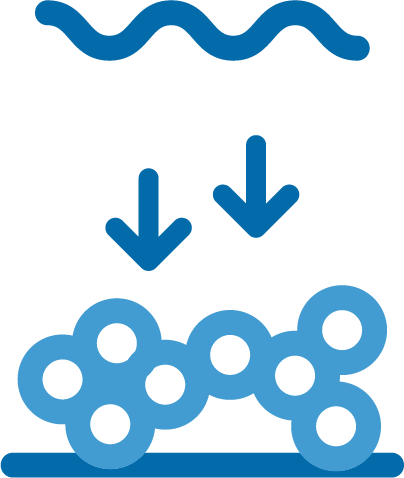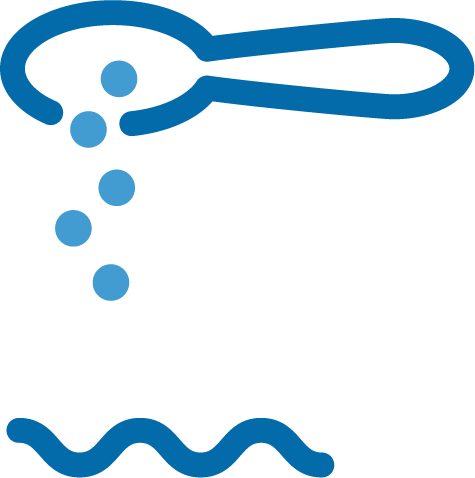Stormwater is defined as runoff water resulting from precipitation. It can contain a variety of pollutants that can harm and hamper our environment. Everything from oil spills, gasoline dripping from a nozzle, pesticides/herbicides being applied, to wash water coming from washing a car or truck eventually ends up in our local waterways. In time, these pollutants can find their way into larger estuaries like the Chesapeake Bay and add up with the multitude of other stormwater runoffs to kill off the aquatic life there.
Our ecosystem is a circular one, as depicted in the diagram. Since matter is neither created nor destroyed, we have to reuse our most precious resource: water. The water that rains down on us picks up pollutants and deposits them in our waterways before it evaporates back into the clouds. When it does so, it increases the pollutant concentration in our waterways, as the pollutants do not evaporate, but accumulate instead.

What Goes On the Ground Sticks Around!
Impervious media, such as asphalt and concrete, that accompany urban areas create problems with the water from precipitation recycling through our ecosystem. The water runs off too fast for natural evapotranspiration and/or groundwater recharge to take place. In the process of runoff, the water picks up the oils and other pollutants that are on the paved surfaces. Even something as simple as pet waste left on a sidewalk makes an impact on the waters around us.
Some estimates predict that the Chesapeake Bay will be devoid of aquatic life within the next 50 years if we continue polluting at our current rate.
The County of Henrico has a massive and complex piping system to handle our rainwater. This includes underground systems as well as above ground ditches, culverts, streams, creeks, and rivers. Whenever you see water flowing during a storm, that water—along with anything it carries—will eventually end up in the Chesapeake Bay.
Why is it a concern?
Stormwater picks up any and all pollutants that are on the ground when it precipitates. Chemicals, debris, dirt, and other pollutants flow with stormwater into either a storm sewer system or directly into lakes, streams, creeks, rivers, and eventually the Chesapeake Bay and Atlantic Ocean. Anything that enters a storm sewer system is discharged without treatment into the water bodies we use for swimming, fishing, and drinking water.

Sediment
Excess sediment is a serious pollutant. When sediment enters our streams and creeks, it can kill plants by clouding water and blocking their source of sunlight or kill fish by clogging their gills. Vegetative buffers act as a filter, slowing stormwater flow and allowing groundwater penetration. They also prevent the loss of topsoil and deposition of silt and sediment into the waterways.

Excess Nutrients (Fertilizers)
By far the biggest contributor to the poor state of the Chesapeake Bay’s waters to date, excess nutrients can cause algae blooms to grow out of control. When these blooms die, they decompose on the bottom of the waterway. While decomposing, they use up large amounts of oxygen in the process, which in turn, kills fish and other aquatic life forms that need oxygen to survive. Simple things like following the directions on fertilizer products and fertilizing your lawn in the fall instead of the spring can make a big impact on improving the Bay’s waters.
Fall fertilization is superior for a few reasons:
The amount of rain in the spring is much greater, taking more of the fertilizer with it into the waterways and leaving less fertilizer on your lawn
- Grass plants produce more root mass and a deeper root system resulting in an overall healthier plant
- Disease and weed problems are usually less severe
- Heat and drought tolerance are usually better, enhancing the summer lawn quality

Debris
Bags, bottles, plastic six-pack rings, and even cigarette butts washed into water bodies can choke, suffocate, and disable aquatic life such as ducks, fish, turtles, and birds. The #1 thing people can do to help protect our waterways is stop polluting!

Household Chemicals
Insecticides, pesticides, paint, solvent, used motor oil, and other fluids can poison and kill aquatic life. Land animals and people can become sick or die from eating diseased fish and shellfish or ingesting polluted water. The landfill in Henrico County accepts household cleaners—use it instead of pouring your excess on the ground.
Used Oil – Appliances – Household Hazardous Waste Collection
Drinking Water
Polluted Stormwater often affects drinking water sources. This, in turn, can affect human health and increase drinking water treatment costs. Once pollutants enter our drinking water sources, it takes a long time for them to be filtered out of the system. The more we pollute our drinking water sources, the more the system becomes overloaded, leading to a slower process of filtering out pollutants.
Please remember, ditches and storm drains are not connected to the sanitary sewer system. Whatever you put into ditches, street drains, and even onto your lawn, flows immediately into our recreational waters whenever there is a significant rain. We must all assume accountability for keeping pollutants out of our waters.
How Does Stormwater Pollution Affect Me?
From destroying the local habitats of wildlife to spreading possible diseases, stormwater pollution is a problem that has a wide scope of consequences.
- Contaminated drinking water — Since our primary water source is the James River, discharging pollutants into it eventually brings those pollutants back into our bodies
- Mosquito breeding — Clogged water ways give mosquitoes more places to breed. Many types of mosquitoes that can spread diseases to humans prefer to breed in polluted water
- Lack of seafood — One of the most precious local resources in this region is the seafood. The crabs, oysters, fish, and clams are becoming depopulated to a dangerous point because of waterway pollution. If things don’t improve soon, the Chesapeake Bay’s seafood and its surrounding waterways could cease to exist
- Recreation/swimming hazards — Bacteria and other pathogens can wash into swimming areas and create health hazards, often making beach closures necessary.
What can I do to help?
There are many seemingly harmless household activities that wreak havoc with our water system. You can help by implementing your own Best Management Practices (BMPs) around the house. BMP is a general term applicable to any means, practice, or technique that aims to significantly reduce or eliminate storm water pollution. Click here to learn more about what you can do to reduce pollution.
Be Part of The Solution…Don’t Pollute!
For questions or to report a concern regarding our stormwater system, contact [email protected] or call 804-501-7319.




